This is the C-119 Flying Boxcar. Used in the film, "Flight of the Phoenix" This behemoth of an aircraft was used by both civilians and the military. Here is some history. The aircraft saw extensive action during the Korean War as a troop and equipment transport. In July 1950, four C-119s were sent to FEAF for service tests.[citation needed] Two months later, the C-119 deployed with the 314th Troop Carrier Group and served in Korea throughout the war.[3]
In December 1950, after People's Republic of China Expeditionary People's Volunteer Army troops blew up a bridge [N 1]at a narrow point on the evacuation route between Koto-ri and Hungnam, blocking the withdrawal of U.N. forces, eight U.S. Air Force C-119 Flying Boxcars flown by the 314th Troop Carrier Group.[5][N 2] were used to drop portable bridge sections by parachute. The bridge, consisting of eight separate sixteen-foot long, 2,900-pound sections, was dropped one section at a time, using two parachutes on each section. Four of these sections, together with additional wooden extensions were successfully reassembled into a replacement bridge by Marine Corps combat engineers and the US Army 58th Engineer Treadway Bridge Company, enabling U.N. forces to reach Hungnam.
From 1951 to 1962, C-119C, F and G models served with U.S. Air Forces in Europe (USAFE) and Far East Air Forces (FEAF) as the first-line Combat Cargo units, and did yeoman work as freight haulers with the 60th Troop Carrier Wing, the 317th Troop Carrier Wing and the 465th Troop Carrier Wing in Europe, based first in Germany and then in France with roughly 150 aircraft operating anywhere from Greenland to India. A similar number of aircraft served in the Pacific and the Far East. In 1958, the 317th absorbed the 465th, and transitioned to the C-130s, but the units of the former 60th Troop Carrier Wing, the 10th, 11th and 12th Troop Carrier Squadrons, continued to fly C-119s until 1962, the last non-Air Force Reserve and non-Air National Guard operational units to fly the "Boxcars."
The USAF Strategic Air Command had C-119 Flying Boxcars in service from 1955 to 1973.
Perhaps the most remarkable use of the C-119 was the aerial recovery of balloons, UAVs, and even satellites. The first use of this technique was in 1955, when C-119s were used to recover Ryan AQM-34 Firebee unmanned targets.[6] The 456th Troop Carrier Wing, which was attached to the Strategic Air Command (SAC) from 25 April 1955 – 26 May 1956, used C-119s to retrieve instrument packages from high-altitude reconnaissance balloons. C-119s from the 6593rd Test Squadron based at Hickam Air Force Base, Hawaii performed several aerial recoveries of film-return capsules during the early years of the Corona spy satellite program. On 19 August 1960, the recovery by a C-119 of film from the Corona mission code-named Discoverer 14 was the first successful recovery of film from an orbiting satellite and the first aerial recovery of an object returning from Earth orbit.[7]
The C-119 went on to see extensive service in French Indochina, beginning in 1953 with aircraft secretly loaned by the CIA to French forces for troop support. These aircraft were generally flown in French markings by American CIA pilots often accompanied by French officers and support staff. The C-119 was to play a major role during the siege at Dien Bien Phu, where they flew into increasingly heavy fire while dropping supplies to the besieged French forces.[8] The only two American pilot casualties of the siege at Dien Bien Phu were James B. McGovern Jr. and Wallace A. Buford. Both pilots, together with a French crew member, were killed in early June, 1954, when their C-119, while making an artillery drop, was hit and crippled by Viet Minh anti-aircraft fire; the aircraft then flew an additional 75 miles (121 km) into Laos before it crashed.
During the Sino-Indian War of 1962, the C-119 was extensively used to supply Indian forces. President Kennedy allowed sales of spare C-119 on a priority basis upon request by the Indian government.
During the Vietnam War, the incredible success of the Douglas AC-47 Spooky but limitations of the size and carrying capacity of the plane led the USAF to develop a larger plane to carry more surveillance gear, weaponry, and ammunition, the AC-130 Spectre. However, due to the strong demands of C-130s for cargo use there were not enough Hercules frames to provide Spectres for operations against the enemy. The USAF filled the gap by converting C-119s into AC-119s each equipped with four 7.62 minigun pods, a Xenon searchlight, night observation sight, flare launcher, fire control computer and TRW fire control safety display to prevent incidents of friendly fire. The new AC-119 squadron was given the call-sign "Creep" that launched a wave of indignation that led the Air Force to change the name to "Shadow" on 1 December 1968.[9] C-119Gs were modified as AC-119G Shadows and AC-119K Stingers. They were used successfully in both close air support missions in South Vietnam and interdiction missions against trucks and supplies along the Ho Chi Minh Trail. All the AC-119G Gunships were transferred to the Republic of Vietnam Air Force starting in 1970 as the American forces began to be withdrawn.
Fairchild C-119G of the Royal Belgian Air Force in 1965
During the late 1960s and early 1970s, Air National Guard and USAF Reserve pilots flew C-119's to drop parachutist students for the US Army Parachute School at Ft. Benning, Georgia.
After retirement from active duty, substantial numbers of C-119s and R4Qs soldiered on in the U.S. Navy, U.S. Marine Corps, the Air Force Reserve and the Air National Guard until the mid-1970s, the R4Qs also being redesignated as C-119s in 1962. The last military use of the C-119 by the United States ended in 1974 when a single squadron of Navy Reserve C-119s based at Naval Air Facility Detroit/Selfridge Air National Guard Base near Detroit, Michigan, and two squadrons based at Naval Air Station Los Alamitos, California replaced their C-119s with newer aircraft.
Many C-119s were provided to other nations as part of the Military Assistance Program, including Belgium, Brazil, Ethiopia, India, Italy, Jordan, Taiwan, and (as previously mentioned) South Vietnam. The type was also used by the Royal Canadian Air Force, and by the United States Navy and United States Marine Corps under the designation R4Q until 1962 when they were also redesignated as C-119.
Specifications
Spotlights
- Tang0five 3.7 years ago
- ACEPILOT109 3.7 years ago
General Characteristics
- Created On Windows
- Wingspan 54.2ft (16.5m)
- Length 45.5ft (13.9m)
- Height 15.1ft (4.6m)
- Empty Weight 15,080lbs (6,840kg)
- Loaded Weight 16,631lbs (7,544kg)
Performance
- Power/Weight Ratio 0.405
- Horse Power/Weight Ratio 0.24
- Wing Loading 53.9lbs/ft2 (263.0kg/m2)
- Wing Area 308.8ft2 (28.7m2)
- Drag Points 13635
Parts
- Number of Parts 310
- Control Surfaces 9
- Performance Cost 1,193

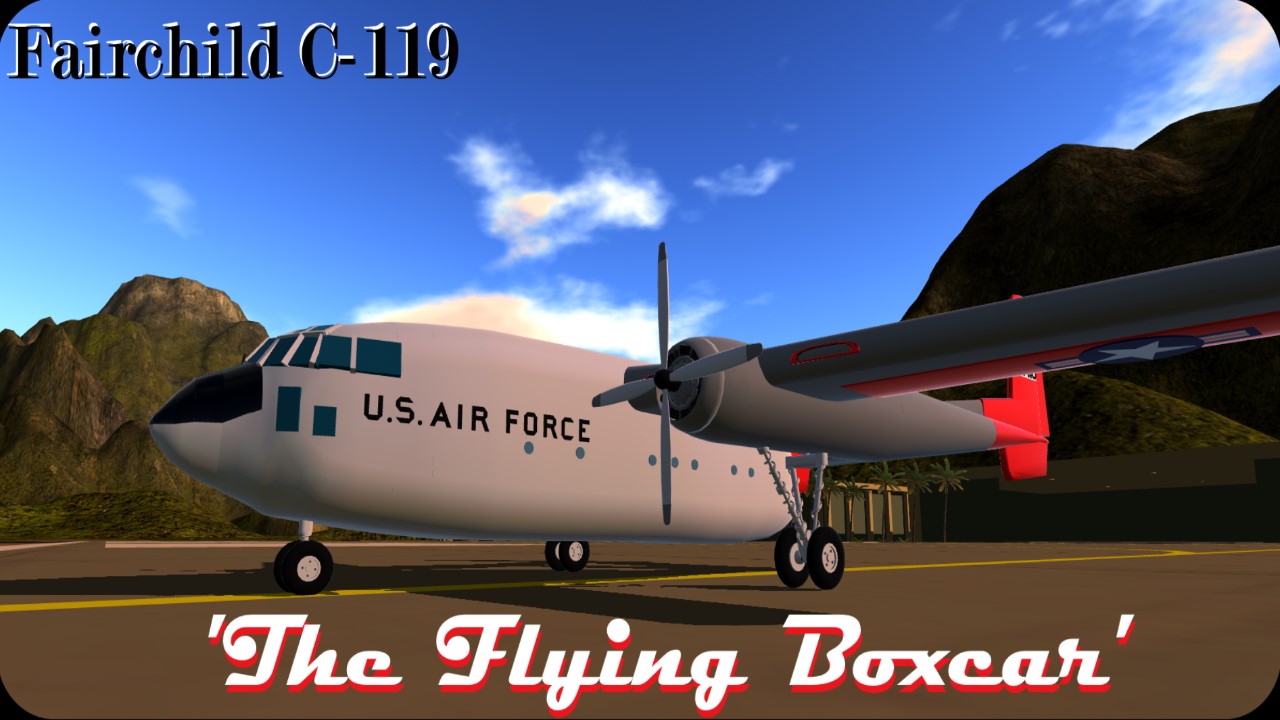
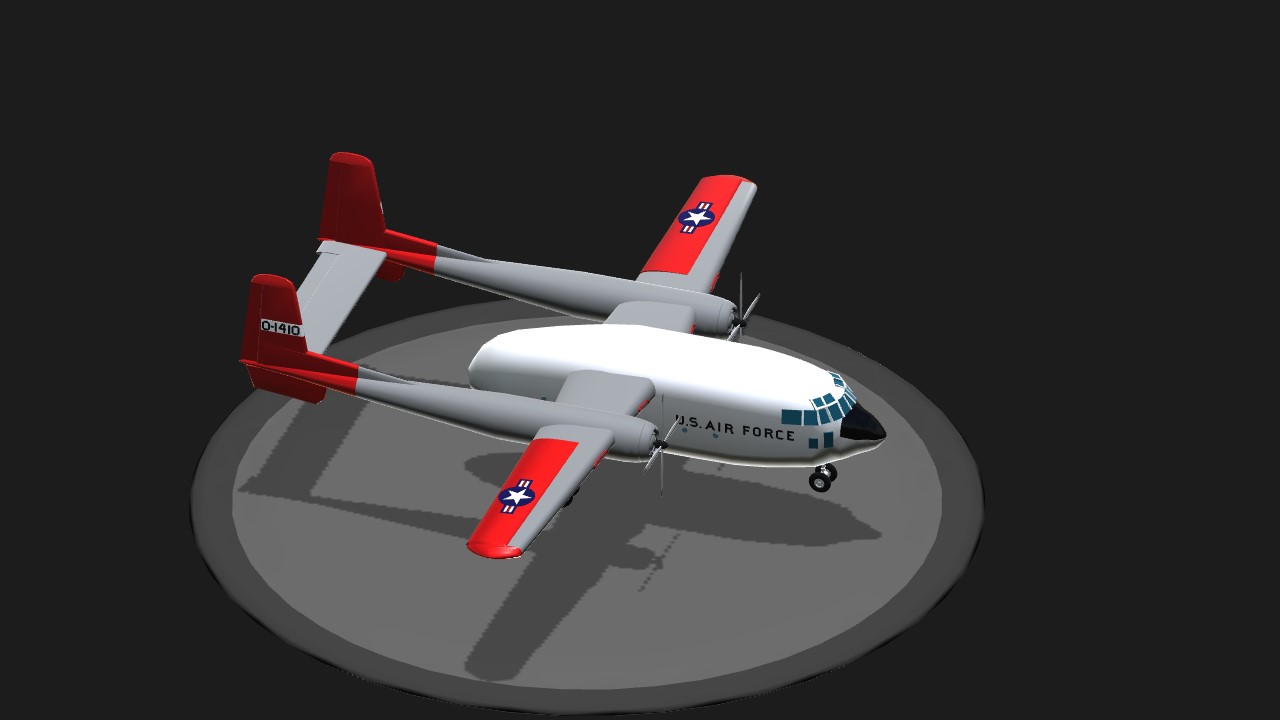
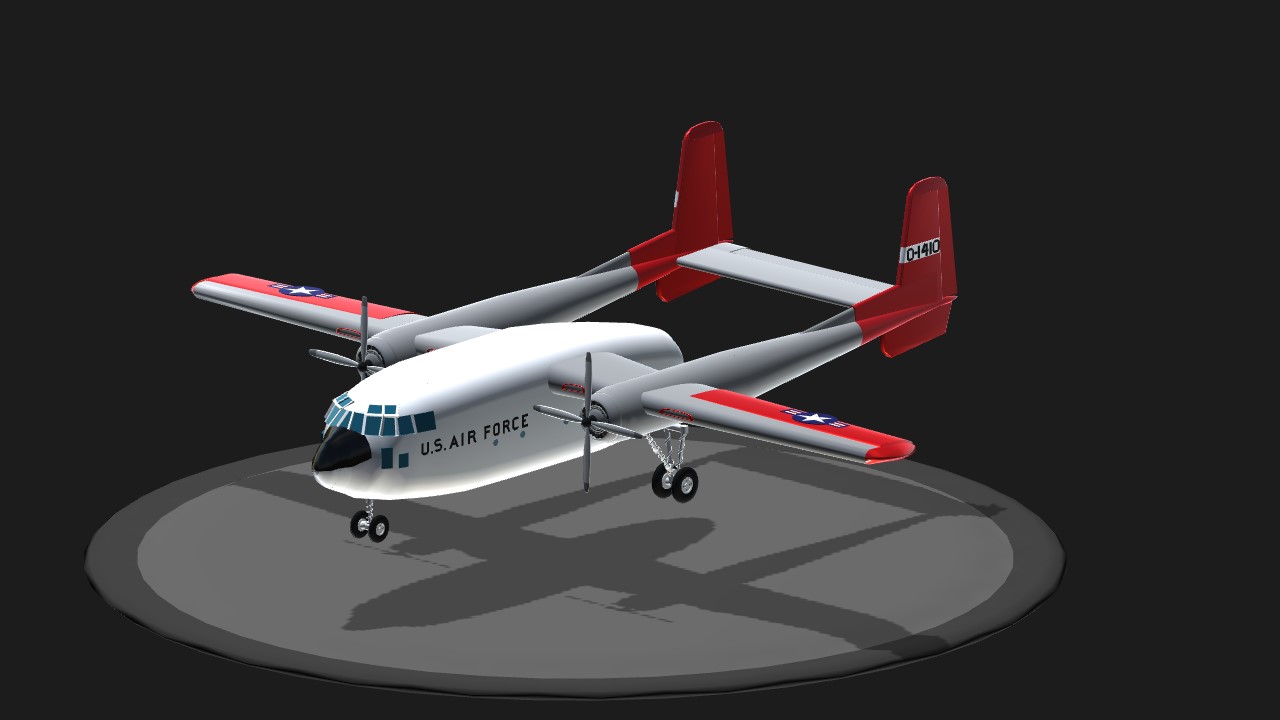
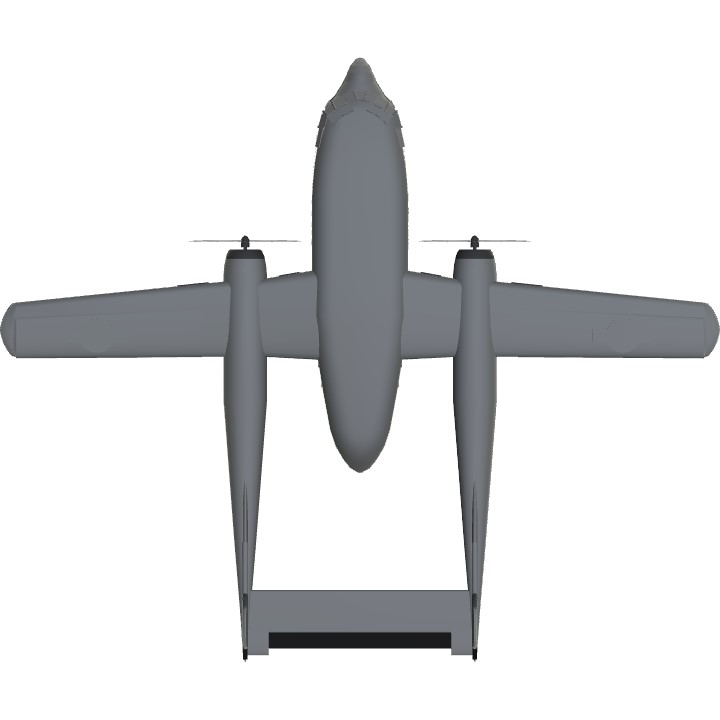
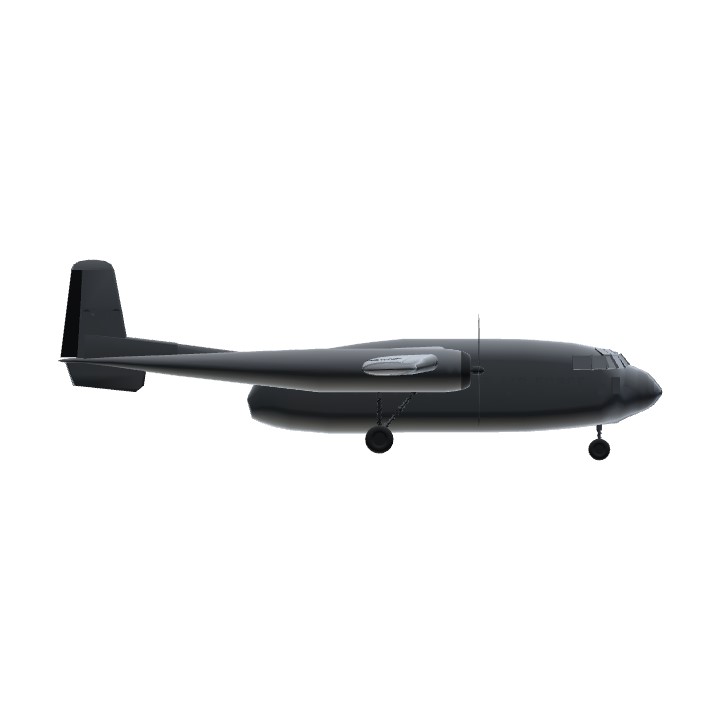
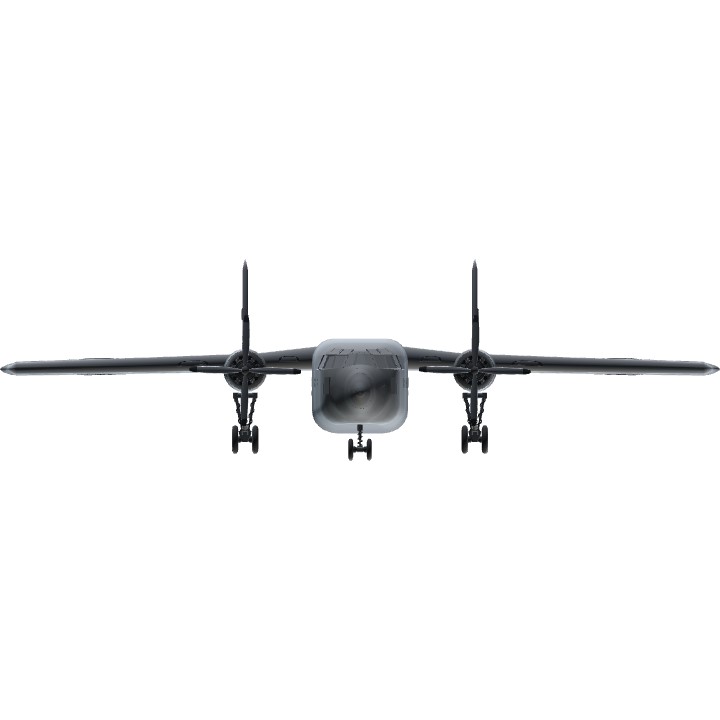
👍